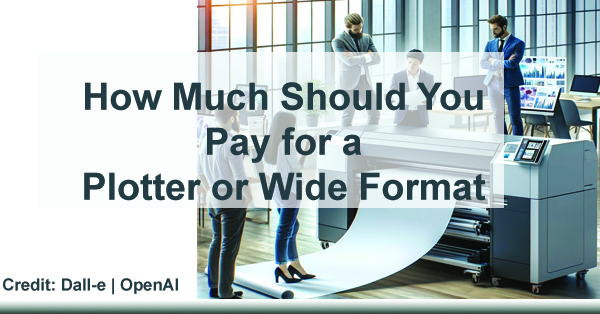
How Much Should You Pay for a Plotter or Wide‑Format Printer?
If you’re an architect, engineer, signage company, or creative team in Colorado, you’re likely asking: How much should I budget for a plotter or wide‑format printer in 2025?
With more models, print sizes, and ink technologies than ever, it’s easy to feel overwhelmed by the options and price points. Whether you’re in Denver, Colorado Springs, or Boulder, this guide will help you understand real‑world pricing, feature sets, and the pros and cons of leasing vs. buying.
📊 Plotter & Wide‑Format Printer Pricing Tiers
Let’s start with an overview of what businesses are typically paying in 2025 based on use case and workload:
| Tier | Price Range | Best For |
|---|---|---|
| Entry‑Level | $2,500 – $4,000 | Small offices, freelancers, residential architects |
| Mid‑Range | $4,000 – $7,000 | Construction firms, design studios, schools, municipal offices |
| High‑End | $7,000 – $12,000+ | Sign shops, engineering firms, production print teams |
Prices vary depending on configuration, service contracts, accessories (like scanners or finishers), and installation support.
🧩 What Impacts Plotter Pricing?
- Print Width: Common widths include 24″, 36″, 42″, and 44″. Larger devices cost more and require more workspace.
- Resolution: High‑resolution plotters (1200–2400 DPI) are essential for detailed renderings or marketing visuals.
- Ink System: Dye‑based vs pigment inks; 4‑, 6‑, or 12‑color systems depending on color needs.
- Multifunction Capability: Integrated scanning and copying features—ideal for blueprints and document digitization.
- RAM & Processing Speed: Faster machines with 2‑4 GB RAM, onboard drives, and strong PDF/RIP processors help in busy workflows.
- Connectivity: Wi‑Fi, Ethernet, mobile/cloud printing compatibility if managing remote or field teams.
Want a deep dive into architecture‑specific models? Visit our Architectural Plotter Printer Guide.
🏗️ Real‑World Use Cases in Colorado
- Engineering firm in Colorado Springs: Installed HP DesignJet T2600 with dual rolls and scan‑to‑file functionality for technical drawings with color overlays.
- Sign shop in Lakewood: Upgraded to Epson SureColor T5470M for fast, waterproof poster production and in‑house graphics jobs.
- Architectural firm in Denver: Replaced older plotters with Canon imagePROGRAF TM‑305 to improve resolution, reduce noise, and cut outsourcing expenses.
We’ve helped dozens of businesses statewide find the right plotter—and we’ll help you too.
🏆 Recommended Plotter Models
- Canon imagePROGRAF TM‑305: Excellent for quiet offices needing 36″ color CAD printing with optional scan integration.
- HP DesignJet T1600 Series: Best for engineering firms printing technical sets with heavy daily usage and dual‑roll capacity.
- Epson SureColor T5170 / T5470M: Compact, fast, and popular with smaller shops and mobile or field‑based design teams.
We’re a certified Canon dealer in Colorado and support HP and Epson models with on‑site service, training, and flexible leasing options.
💸 Should You Lease or Buy Your Plotter?
| Leasing | Buying |
|---|---|
| Lower upfront cost | Higher upfront investment |
| Often includes service & supplies | Ongoing service plans extra |
| Predictable monthly payments | Long‑term asset ownership |
| Easy to upgrade in 3‑5 years | Best if you don’t plan to change needs |
If you’re scaling or unsure what your future volume will look like, leasing gives you flexibility without large capital outlay.
💬 Common Questions About Plotter Costs
How much should a small business spend on a plotter?
Most small businesses spend between $3,500 and $6,000 for a high‑quality, mid‑range plotter with reliable output and light scanning capabilities.
Are there ongoing maintenance or ink costs?
Yes. Ink can range from $300–$600 per refill depending on brand and cartridge size. Maintenance varies, but manufacturers typically recommend basic cleaning and firmware updates on a monthly basis. A service contract often helps to control these costs.
Can I use a plotter in a shared workspace?
Yes. Many newer plotters run quietly, include dust protection, and support secure network sharing—ideal for architectural firms or co‑working spaces.
Do I need special software to run a plotter?
Most models integrate with AutoCAD, Revit, and Adobe applications. Print drivers and RIP (raster image processing) software may be recommended for advanced color workflows.
📍 Supporting Colorado’s AEC and Design Communities
ABT is proud to serve professionals across Colorado, including:
- Architects
- Engineering consultants
- Construction firms
- Municipal offices
- Marketing & signage companies
🔗 Related Resources